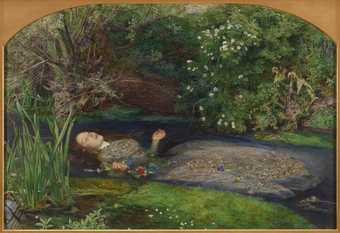
Sir John Everett Millais, BtOphelia 1851–2Tate
Beauty as Protest 1845–1905
17 rooms in Historic and Early Modern British Art
The men and women of the Pre-Raphaelite circle question mainstream Victorian culture and ideas
In 1848, revolutions all over Europe spread the spirit of reform across the continent. Three art students, Dante Gabriel Rossetti, John Everett Millais and William Holman Hunt, launch a revolution in art. Rossetti is the son of an Italian revolutionary. Hunt worked in a textile warehouse for the popular political activist, Richard Cobden. Hunt and Millais watch Chartist campaigners march on parliament to petition for workers’ rights. In November 1848, the trio create a radical artistic group called the Pre-Raphaelite Brotherhood.
The Pre-Raphaelites reject the academic art of the Royal Academy, which holds certain historical subjects and styles in high esteem. They look for authenticity in art of all periods, but seek relevance to their modern times. The seven members, alongside the men and women in their wider circle, choose subjects that cast a light on social issues. They update stories from the Bible, Shakespeare and medieval poetry. They paint real people, objects and settings. Later on, their art becomes concerned with beauty and imagined worlds.
William Morris, News from Nowhere 2015
1/30
artworks in Beauty as Protest
Morris & Co. (London, UK), Pipernel design, wallpaper book 1917–1939
2/30
artworks in Beauty as Protest
Anne Gaskell, Gaskell Wall Clock 1848
3/30
artworks in Beauty as Protest
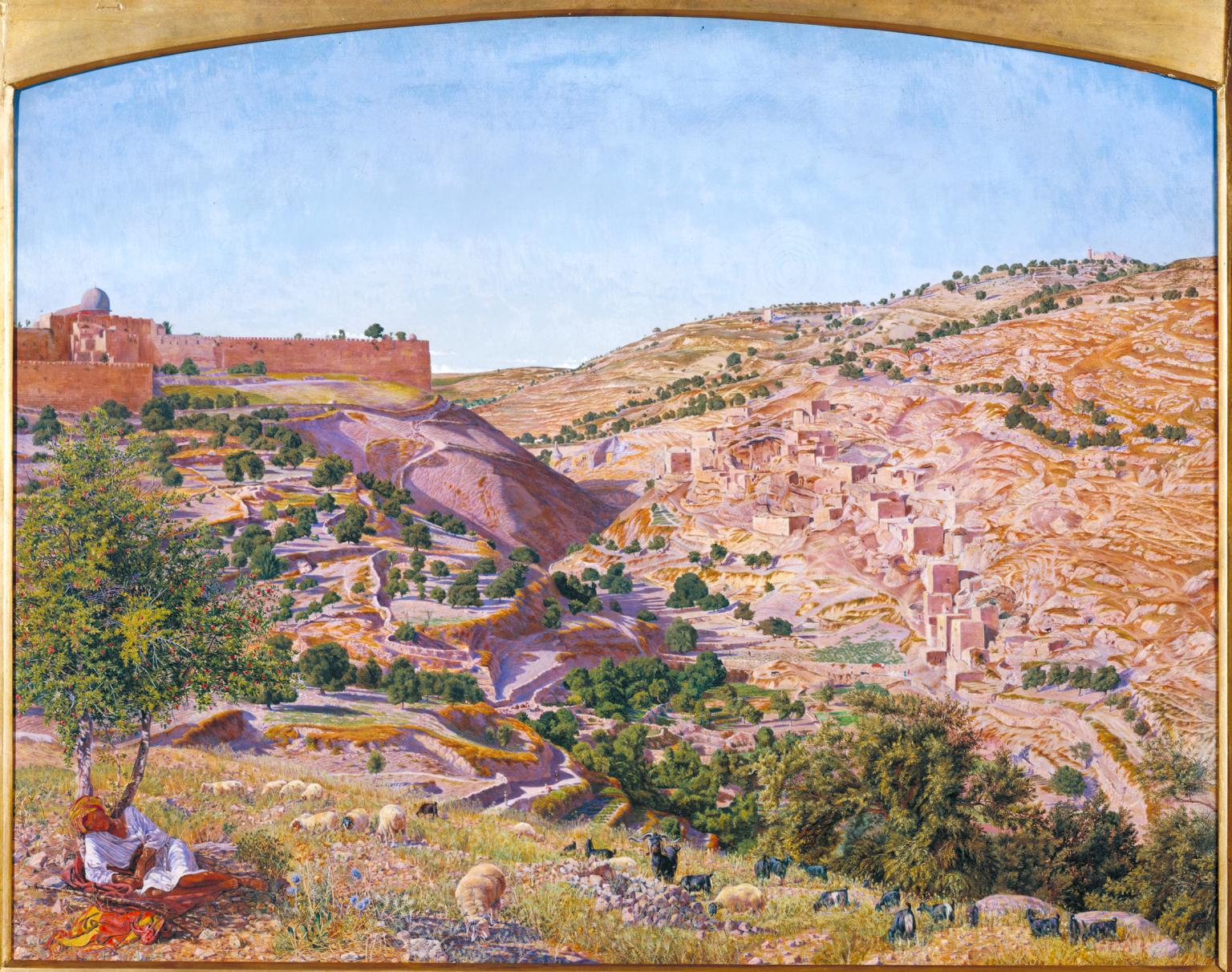
Thomas Seddon, Jerusalem and the Valley of Jehoshaphat from the Hill of Evil Counsel 1854–5
Seddon and his friend Holman Hunt journeyed to the Holy Land in 1854, to bring greater authenticity, spiritual and topographical, to their religious works. This view, painted south of Jerusalem, shows the Mount of Olives and the Garden of Gethsemane, the site of Christ’s anguish before the Crucifixion. The valley of Jehoshaphat was also believed to be where the Last Judgement would take place. Unlike John Martin’s apocalyptic visions, displayed nearby, Seddon represents the site in painstaking, sun-lit detail, paralleling the art critic John Ruskin’s remarks that ‘in following the steps of nature’, artists were ‘tracing the finger of God.’
Gallery label, March 2010
4/30
artworks in Beauty as Protest
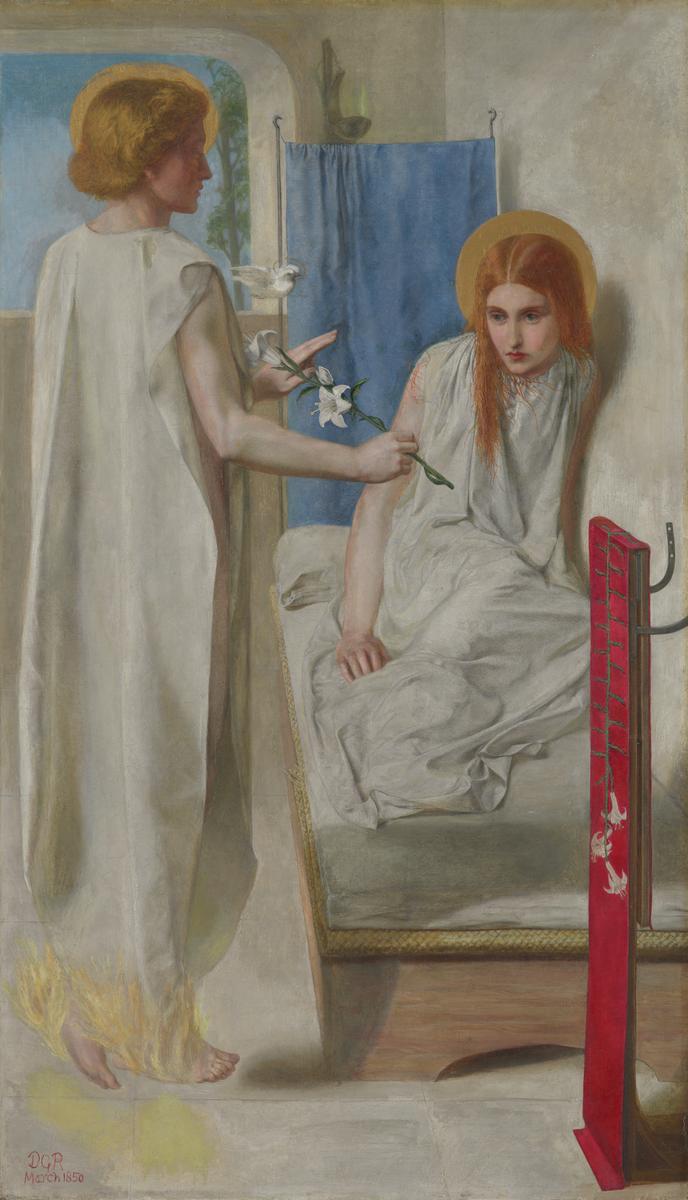
Dante Gabriel Rossetti, Ecce Ancilla Domini! (The Annunciation) 1849–50
In this radical reinterpretation of the Annunciation in which the angel announces to Mary that she will give birth to the Christ child, Rossetti sought a supernatural realism. Rejecting the tradition of representing the Virgin passively receiving the news, he shows her recoiling on her bed as if disturbed from sleep. Rossetti used white as the dominant colour to symbolise feminine purity, complemented by blue, a colour traditionally associated with Mary, and red, for Christ’s blood. The artist’s sister Christina posed for the Virgin and his brother William Michael for the angel.
Gallery label, November 2016
5/30
artworks in Beauty as Protest
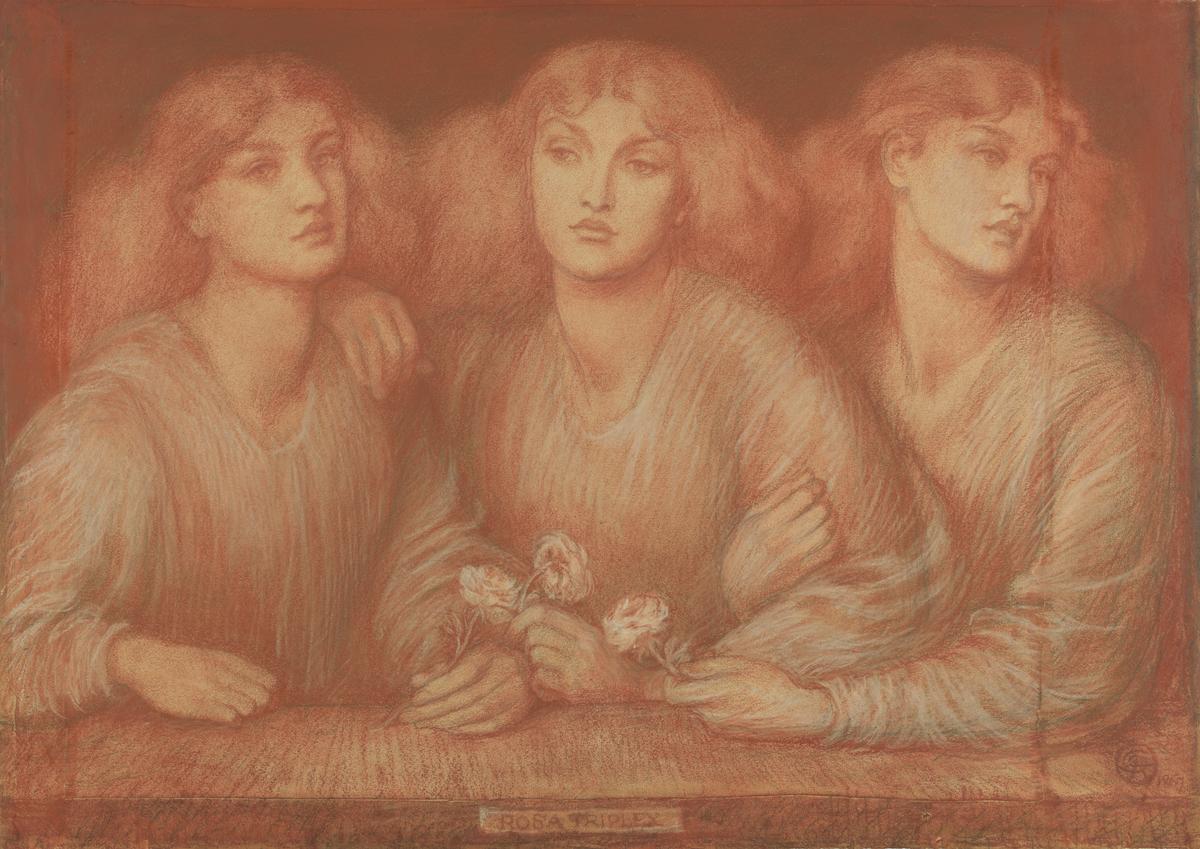
Dante Gabriel Rossetti, Rosa Triplex 1867
triple portrait of Charles I by Van Dyck. Rossetti's
Gallery label, August 2004
6/30
artworks in Beauty as Protest
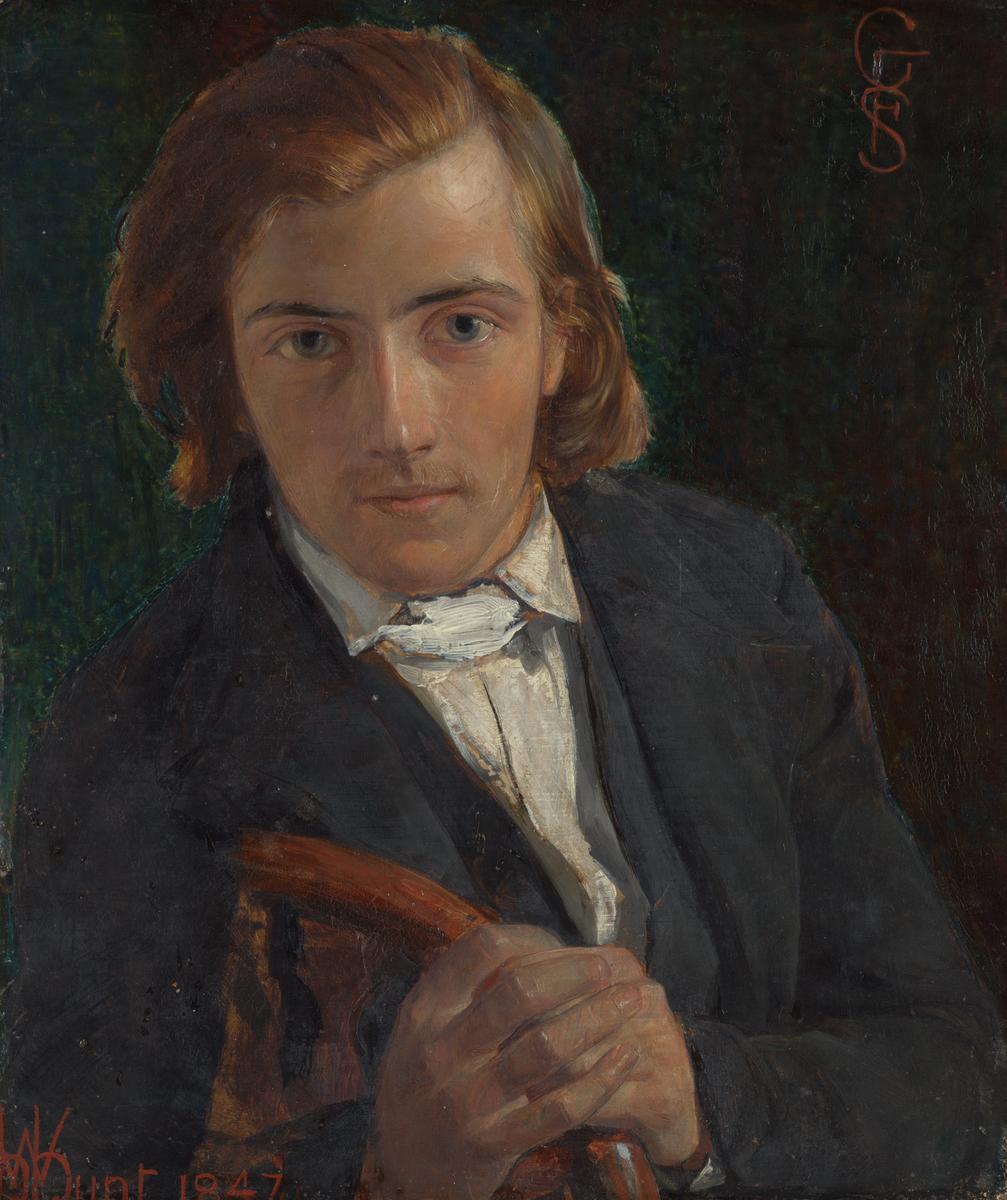
William Holman Hunt, F.G. Stephens 1847
This is F G Stephens. He was a friend of the artists Holman Hunt, John Everett Millais, Dante Gabriel Rossetti and Ford Madox Brown from their studies at the Royal Academy Schools. He modelled for many of their paintings and joined the Pre-Raphaelite Brotherhood in 1848. This portrait was made before the formation of the brotherhood and it is much more loosely painted than strictly Pre-Raphaelite works.Stephens later gave up painting to work as a critic and writer. His reviews helped to advance the cause of contemporary British art and were particularly favourable to his former Pre-Raphaelite colleagues.
Gallery label, July 2007
7/30
artworks in Beauty as Protest
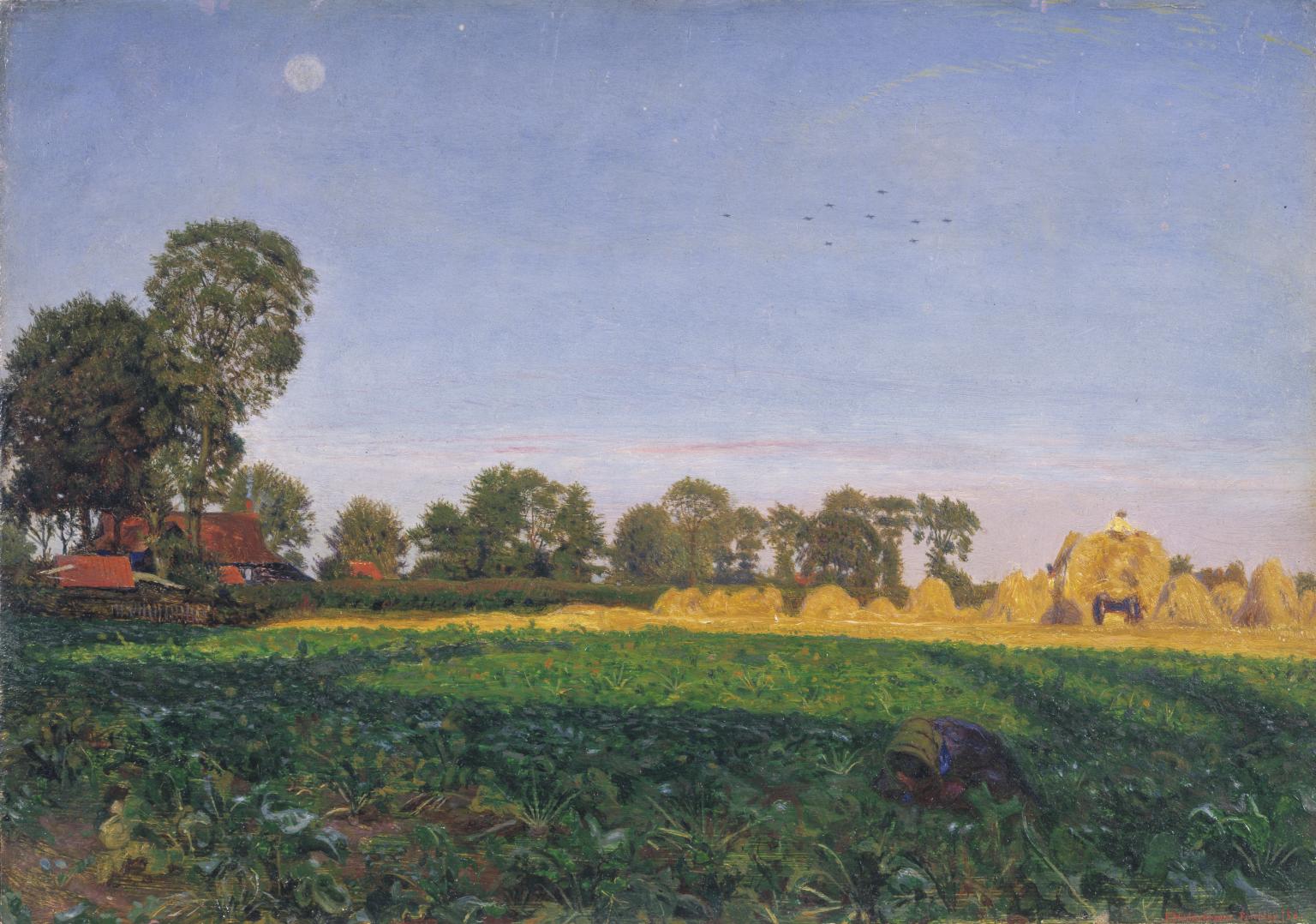
Ford Madox Brown, Carrying Corn 1854–5
This intensely coloured painting captures a harvest field just before sunset. Each landscape element is faithfully recorded in jewel-like colours. This is a nostalgic view of rural England, untouched by industrialisation and modern city life. Ford Madox Brown’s view is typical of idealists of the time who believed that an engagement with nature offered spiritual redemption from urban corruption. Brown and his family were facing financial hardship at the time this picture was painted. It was one of a number of ‘potboilers’, modest and straightforward landscapes he hoped would sell easily.
Gallery label, July 2007
8/30
artworks in Beauty as Protest

Dante Gabriel Rossetti, Proserpine 1874
In the classical myth Proserpine was kidnapped by Pluto, the god of the underworld, to be his wife. Eating food from the underworld would cause a living person to stay there forever. Proserpine ate six pomegranate seeds, and so Pluto confined her to his kingdom six months of each year. She is shown here eating a pomegranate which symbolises captivity. Jane Morris (née Burden) modelled for Proserpine. She was an embroiderer and artist’s model who was married to Rossetti’s friend William Morris and was also Rossetti’s lover.
Gallery label, August 2018
9/30
artworks in Beauty as Protest

William Holman Hunt, Our English Coasts, 1852 (‘Strayed Sheep’) 1852
The location shown in this painting is the Lovers’ Seat, an idyllic spot at Fairlight Glen near Hastings in Sussex. Hunt laboured here from mid-August to December 1852, enduring rain, wind and bitter cold to master his view. Despite the changes in weather, the painting seems a credible replication of particular illuminated moment. The colours used to convey light are daringly juxtaposed in order to intensify the clarity of every surface, a method that astounded audiences on both sides of the Channel.
Gallery label, November 2016
10/30
artworks in Beauty as Protest
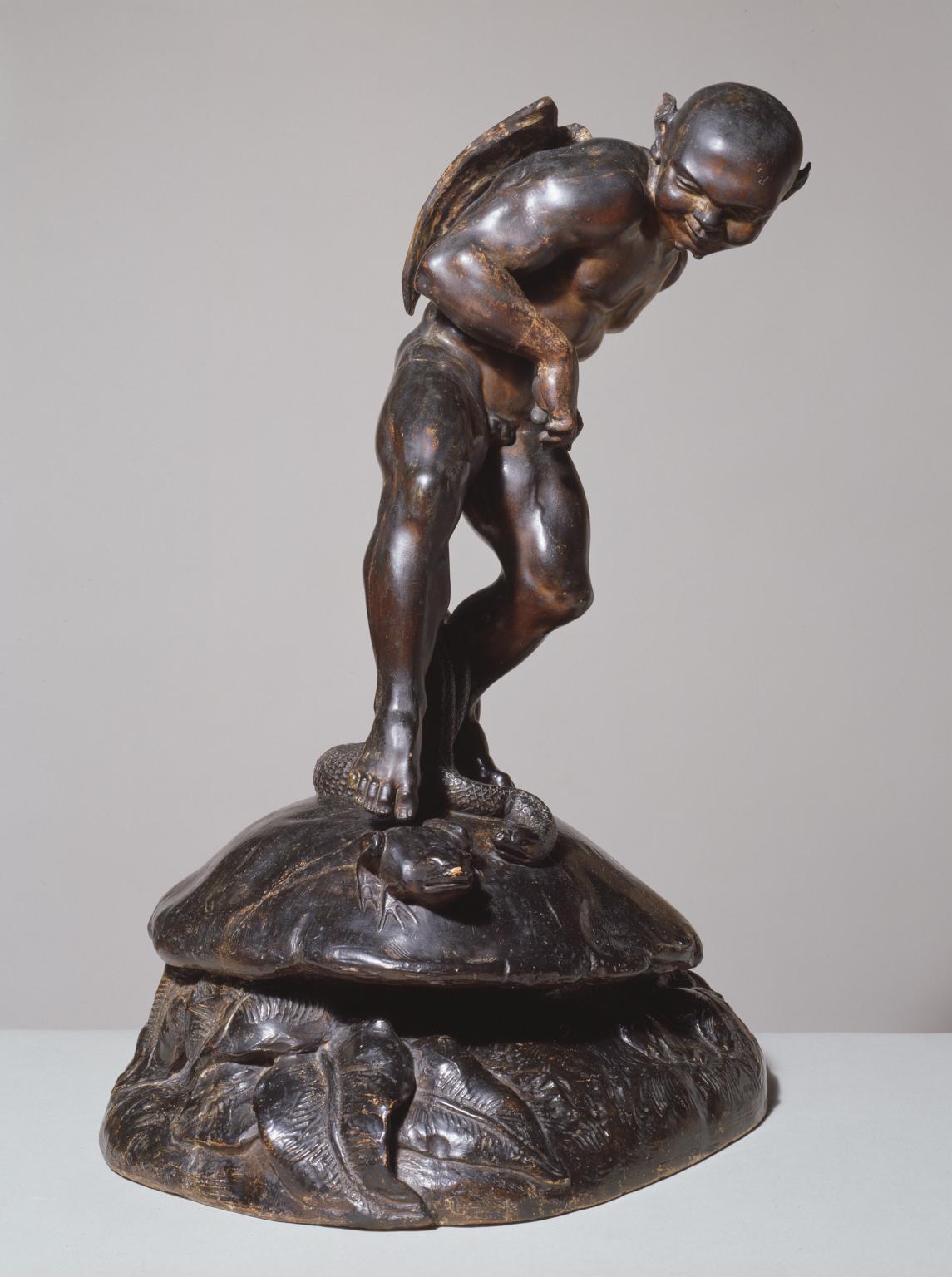
Thomas Woolner, Puck 1845–7
Puck is a mischievous invisible fairy in Shakespeare’s A Midsummer Night’s Dream. Thomas Woolner has illustrated a scene here from an ‘Imaginary Biography’ of Puck. He alights on a mushroom to save a sleeping frog from a hungry snake. The sculpture captures the instant before a sudden movement – as Puck touches the frog with his foot it will jump away just before the snake attacks.Ideal or poetic subjects drawn from literature, mythology or history, were highly regarded by sculptors in the mid-nineteenth century.
Gallery label, July 2007
11/30
artworks in Beauty as Protest
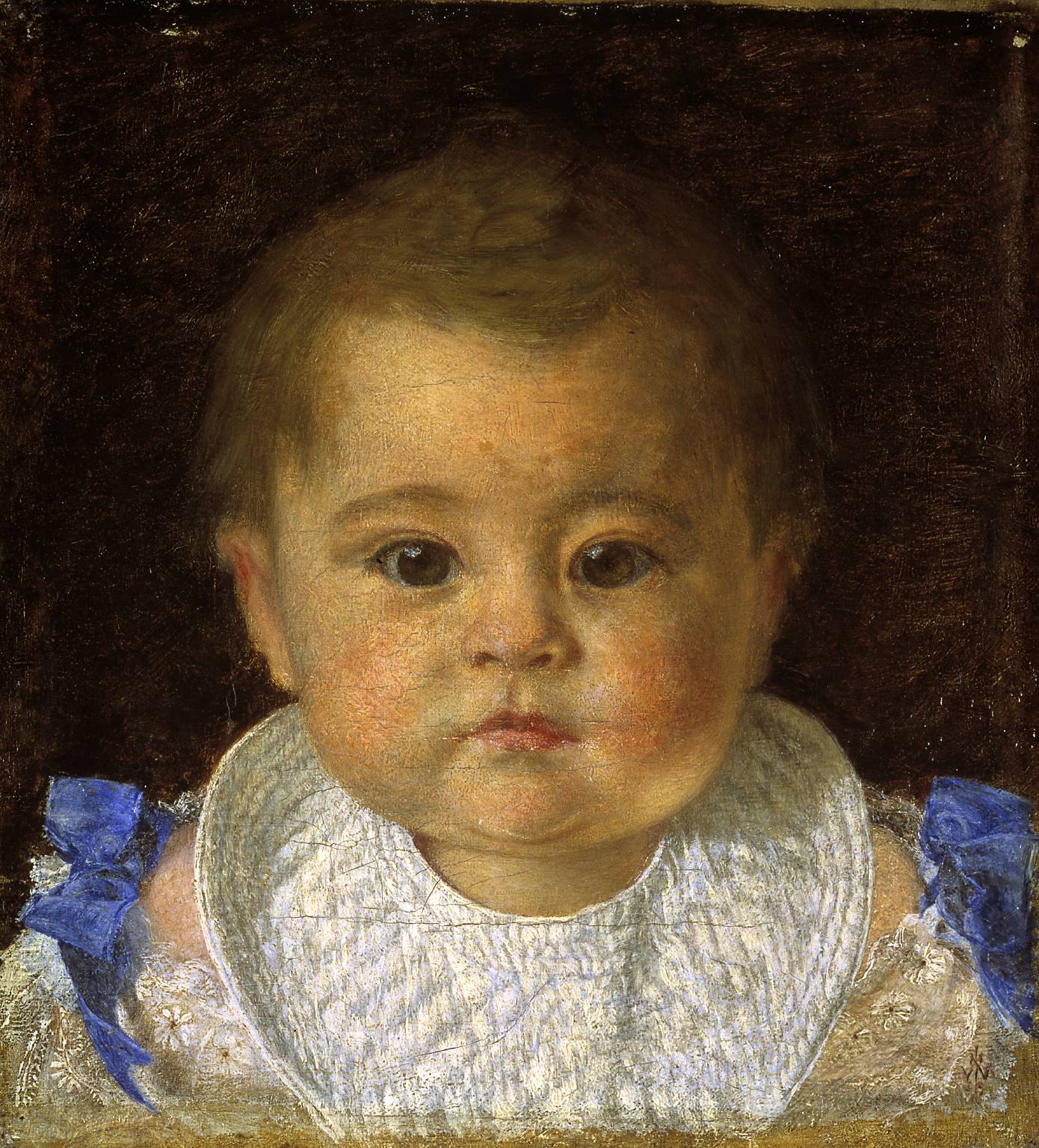
Joanna Mary Wells, Portrait of Sidney Wells 1859
Joanna Mary Wells painted this portrait of her second child, Sidney, while he was still less than a year old. Such a young baby must have been impossible to keep still, which probably explains the difficulty she experienced in seizing a likeness.This has been interpreted as a highly personal work, possibly because of its small icon-like format. It also became a very poignant image after the early deaths of both Sidney and Joanna Mary Wells.
Gallery label, July 2007
12/30
artworks in Beauty as Protest
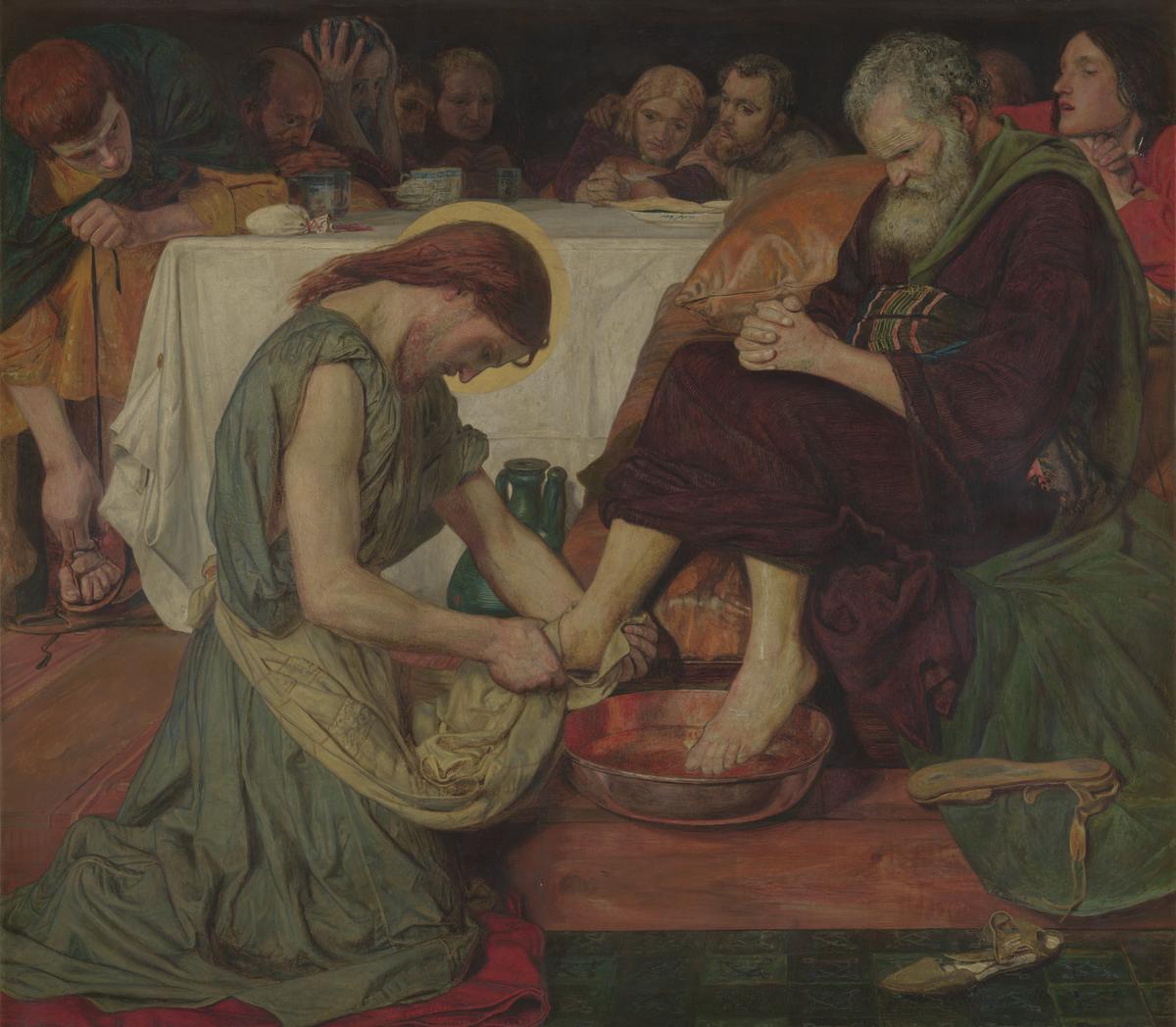
Ford Madox Brown, Jesus Washing Peter’s Feet 1852–6
This picture illustrates the biblical story of Christ washing his disciples’ feet at the Last Supper. It has an unusually low viewpoint and compressed space. Critics objected to the picture’s coarseness – it originally depicted Jesus only semi-clad. This caused an outcry when it was first exhibited and it remained unsold for several years until Ford Madox Brown reworked the figure in robes. Brown was never invited to join the Pre-Raphaelite Brotherhood but he was a close associate of the group. Several members modelled for the disciples in this picture and the critic FG Stephens sat for Christ.
Gallery label, November 2016
13/30
artworks in Beauty as Protest
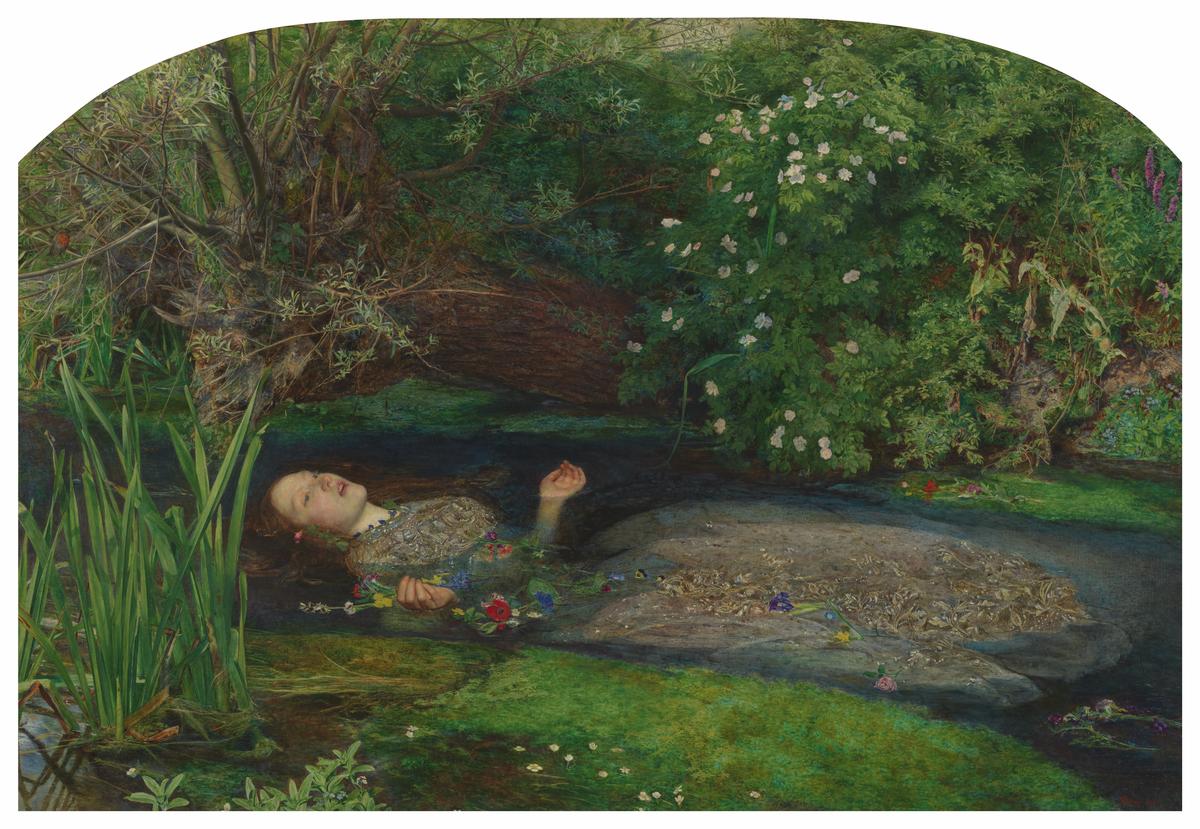
Sir John Everett Millais, Bt, Ophelia 1851–2
This work shows the death of Ophelia, a scene from Shakespeare’s play Hamlet. Traumatised when Hamlet breaks off their betrothal and accidentally kills her father, she allows herself to fall into a stream and drown. The flowers she has been collecting symbolise her story, the poppies representing death. Millais painted the lonely setting leaf-by-leaf over many months by the Hogsmill River, Surrey. Afterwards, the artist, poet and model Elizabeth Siddall posed in a wedding dress in a bath of water at Millais's studio. Through the painting, Millais critiqued the Victorian practice of occasionally arranging marriages for money and status.
Gallery label, March 2022
14/30
artworks in Beauty as Protest
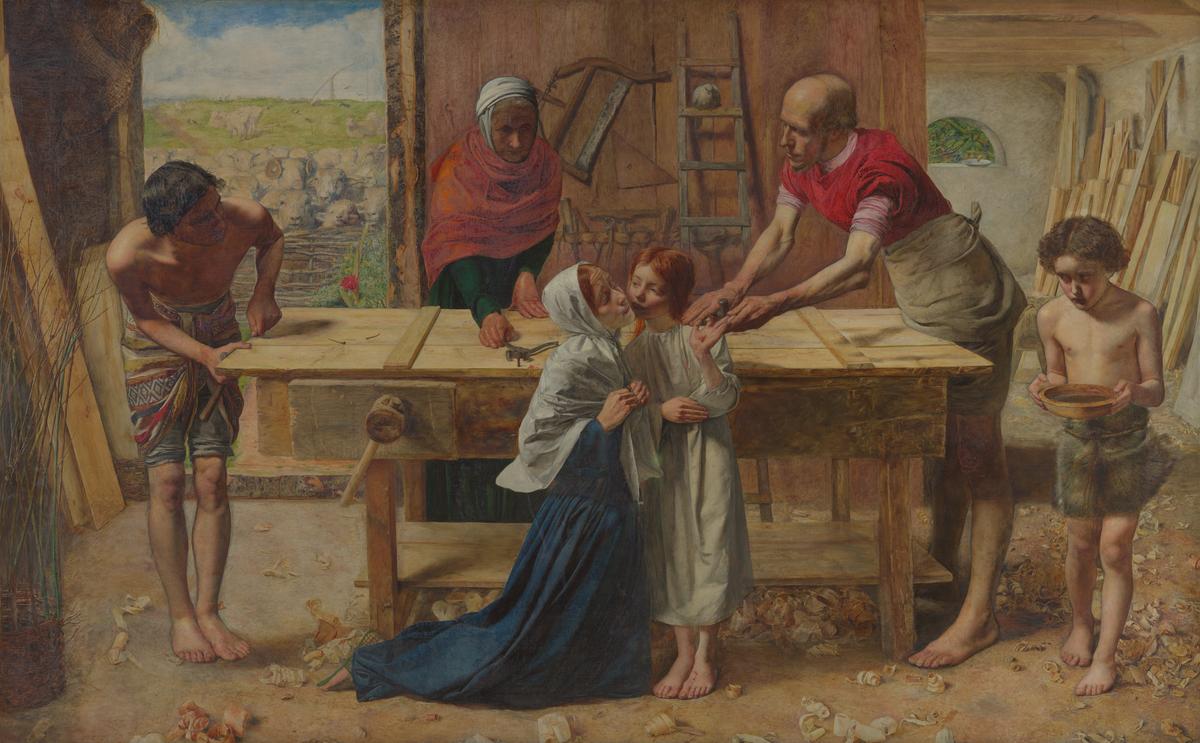
Sir John Everett Millais, Bt, Christ in the House of His Parents (‘The Carpenter’s Shop’) 1849–50
This picture was exhibited with words from the Old Testament, often seen as prefiguring Christ’s Crucifixion: ‘And one shall say unto him, What are these wounds in thine hands? Then shall he answer. Those with which I was wounded in the house of my friends.’ Millais based the setting on a real carpenter’s shop. Symbols of the Crucifixion figure prominently: the wood, the nails, the cut in Christ’s hand and the blood on his foot. Millais was viciously attacked in the press for showing the holy family as ‘ordinary’. Charles Dickens described Christ as ‘a hideous, wry-necked, blubbering, red-haired boy in a night-gown.’
Gallery label, November 2016
15/30
artworks in Beauty as Protest
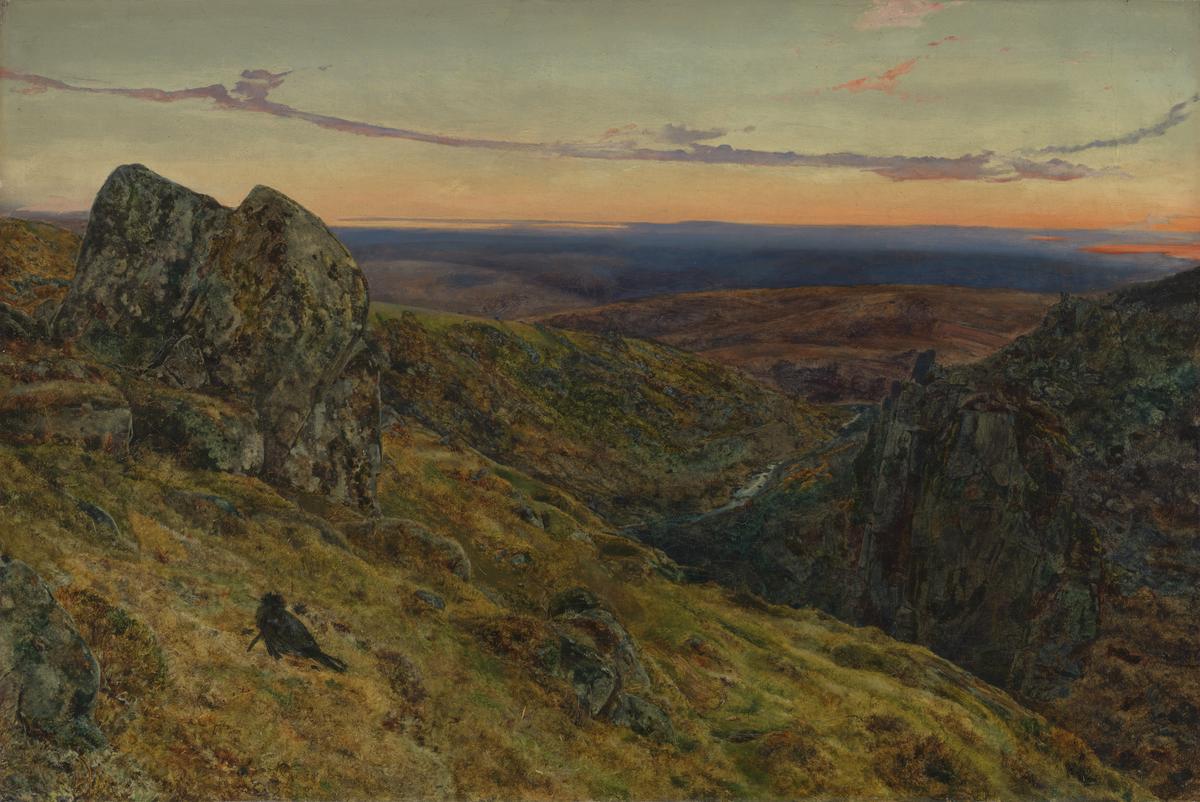
John William Inchbold, The Moorland (Dewar-stone, Dartmoor) 1854
Inchbold, who was born in Leeds, came under the influence of the Pre-Raphaelites in the early 1850s. He established himself as one of the leading landscapists of the movement but by the end of the decade had adopted a broader, more atmospheric approach. Inchbold exhibited a watercolour of the Dewar Stone in 1850, with the subtitle 'the favourite haunt of the poet Carrington', a reference to the Devonshire poet Noel Thomas Carrington. In 1855, making a grander poetical allusion, he exhibited an oil painting titled 'The Moorland - Tennyson'. It is not known whether this was the present picture.
Gallery label, September 2004
16/30
artworks in Beauty as Protest
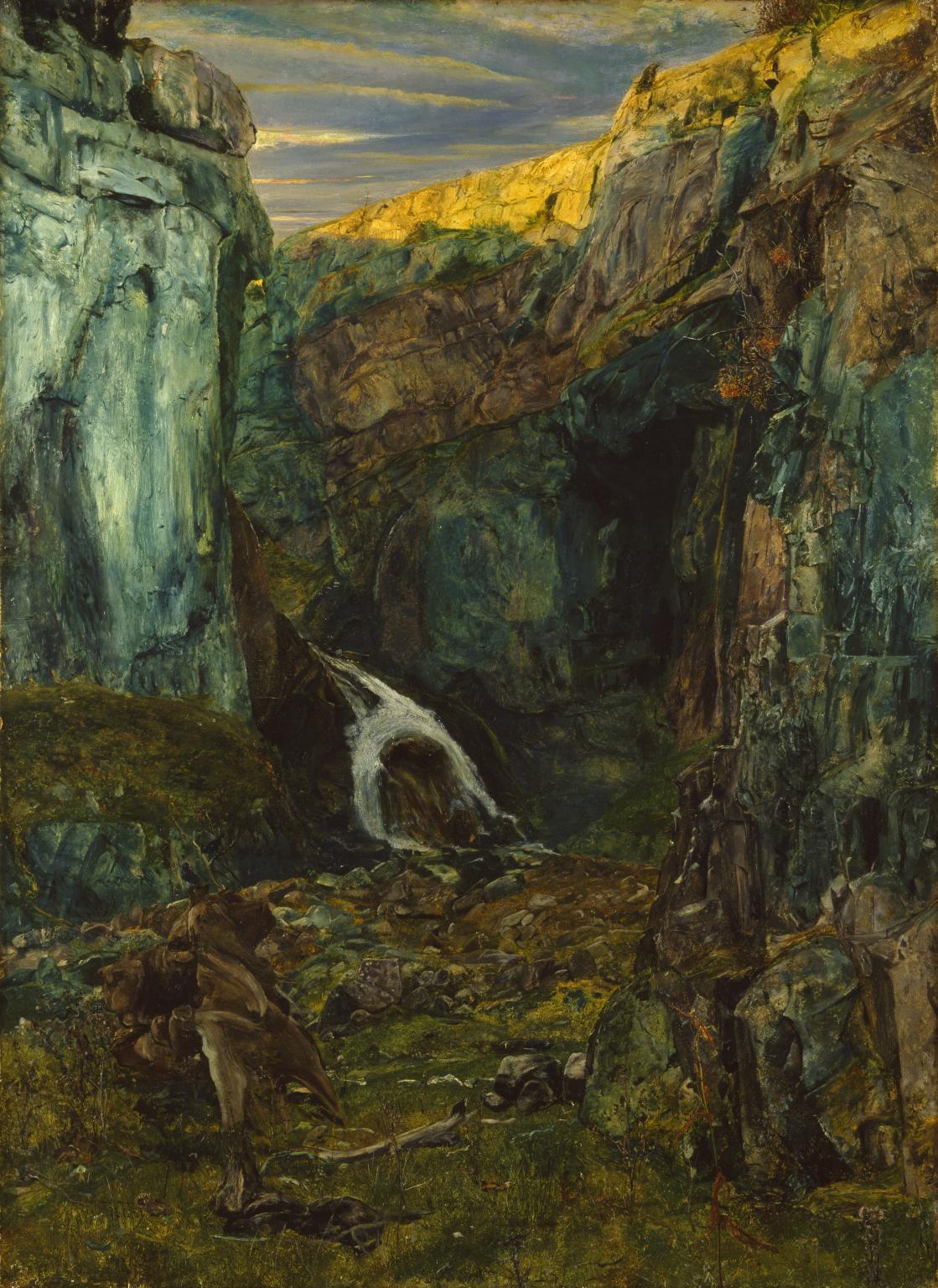
John William Inchbold, Gordale Scar, Yorkshire exhibited 1876
Inchbold, who was born in Leeds, came under the influence of the Pre-Raphaelites in the early 1850s. He established himself as one of the leading landscapists of the movement but by the end of the decade had adopted a broader, more atmospheric approach, as shown here. When it was first exhibited at the Royal Academy it was accompanied by lines from Wordsworth’s sonnet ‘Gordale’ of 1818: ‘... when the air/Glimmers with fading light .../Then, pensive Votary!, let thy feet repair/To Gordale-chasm, terrific as the lair/where the young lions couch; ...’.
Gallery label, November 2016
17/30
artworks in Beauty as Protest
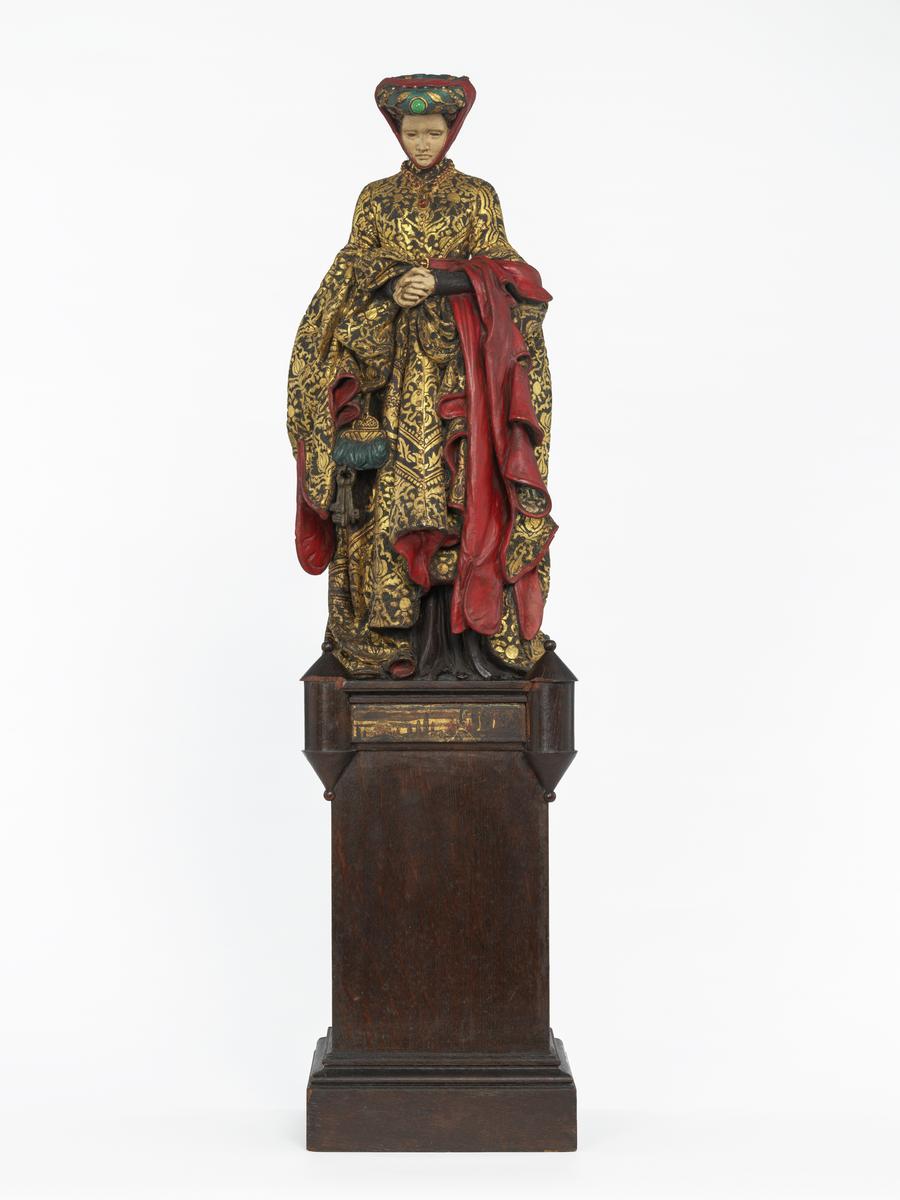
Eleanor Fortescue-Brickdale, The Châtelaine exhibited 1904
The Châtelaine (a French word for a noble woman who is mistress of a castle) is a polychrome, gilded statuette encrusted with semi-precious stones, set on a wooden base with turrets at its four corners and decorated with small Italianate landscapes on all four of its sides. Made of finely modelled plaster, the sculpture is richly patterned, painted and patinated. It represents a noble woman wearing a medieval ‘Balzo’ headdress and an opulent black and gold damask dress lined with red. Her estate is signified by a prominent set of heavy keys hanging from the green purse on her right side. Her face expresses sorrow and her hands are clasped in prayer or anguish. Despite the French title of the work, the figure’s style of dress appears to be Florentine, which is in accord with the Tuscany landscapes that are painted with gold leaf on the wooden base of the sculpture, in the manner of the so-called ‘predella’ scenes situated below sixteenth-century altarpieces. One of them represents a walled city, another a property with cypress trees; a third depicts a more generic landscape and the last one a shore approached by several ships.
18/30
artworks in Beauty as Protest
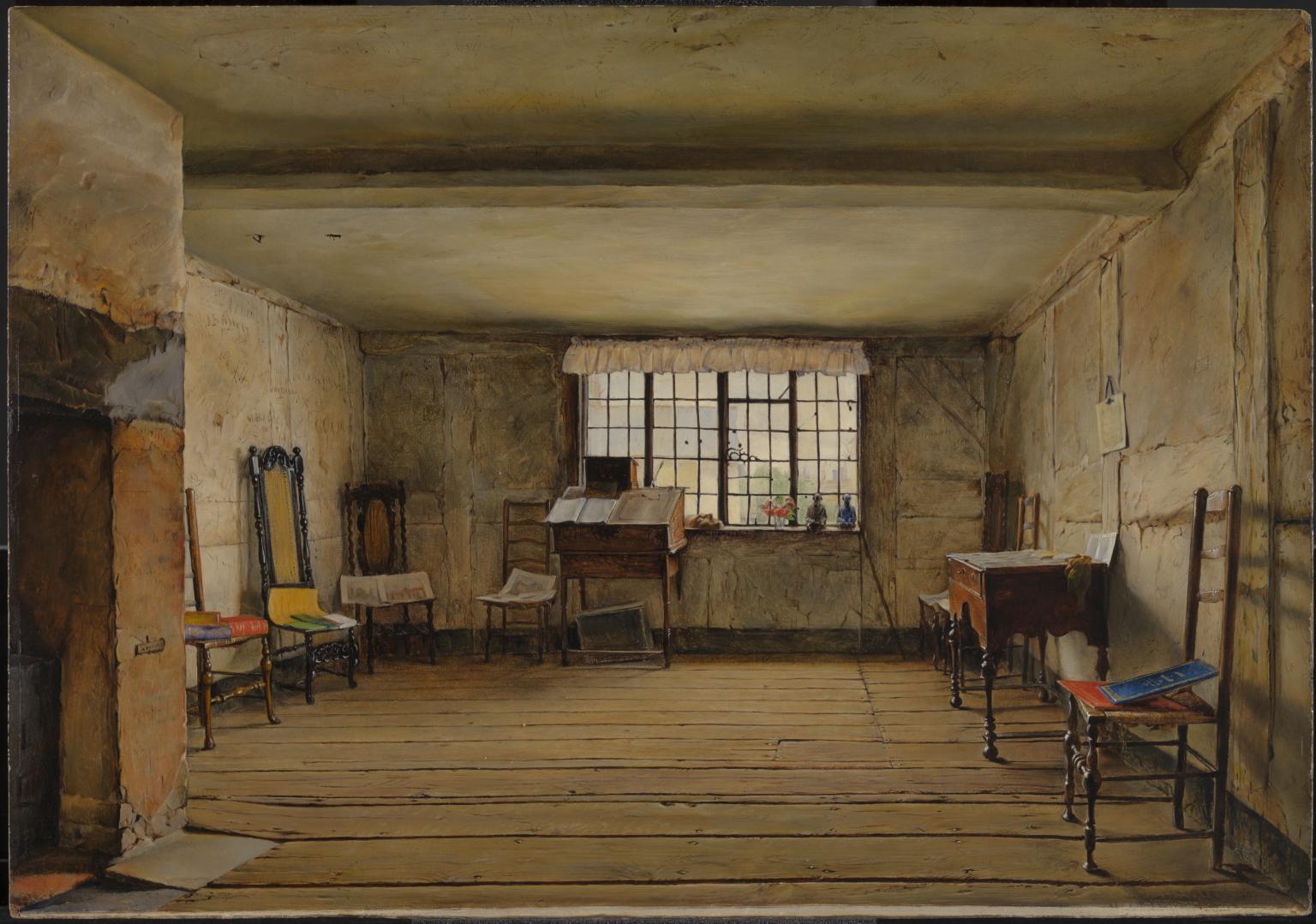
Henry Wallis, The Room in Which Shakespeare Was Born 1853
Wallis launched his career exhibiting a sequence of paintings of interior scenes connected with the life of playwright William Shakespeare (1564-1616). This one shows Shakespeare’s birthplace in Stratford-upon-Avon. It is based on a biography by Charles Knight written in 1842. It describes ‘the mean room, with its massive joists and plastered walls, firm with ribs of oak’. Wallis has painted the room in detail, including every nail securing the floorboards. He has also taken note of Knight’s passage describing how ‘hundreds amongst the hundreds of thousands by whom that name is honoured have inscribed their names on the walls of the room.’
Gallery label, June 2019
19/30
artworks in Beauty as Protest
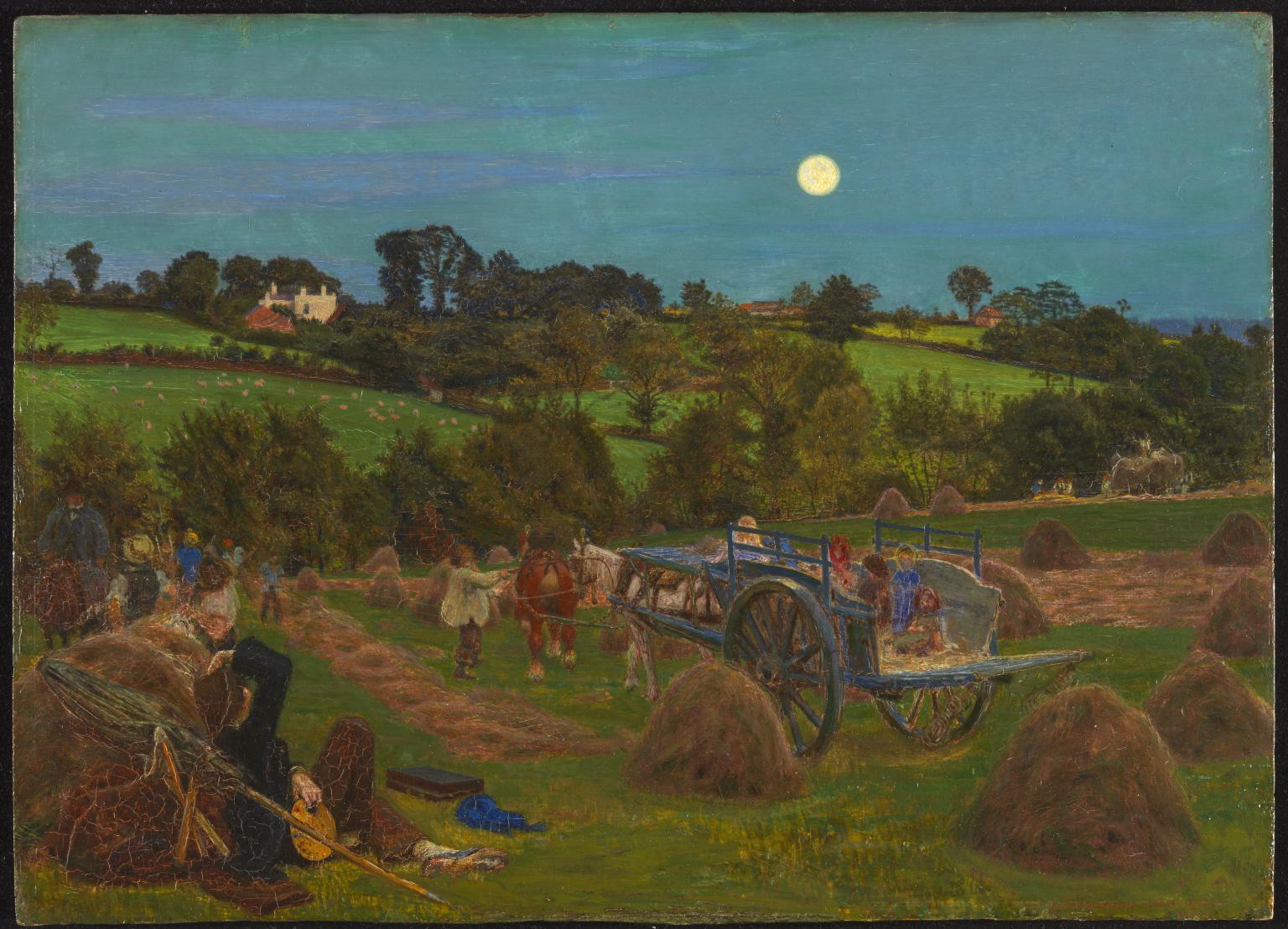
Ford Madox Brown, The Hayfield 1855–6
Brown painted this landscape directly from nature. The setting is the Tenterden estate at Hendon, north London, looking east at twilight. He finished the final details in his studio, adding a self-portrait in the lower left corner. The effect he sought to capture was the way in which the brown hay was made to appear almost pink by contrast with the dense green grass. After it was finished his dealer rejected it on the grounds that he had never seen hay of this colour. Brown later retouched the painting before selling it to his friend and fellow artist William Morris.
Gallery label, November 2016
20/30
artworks in Beauty as Protest
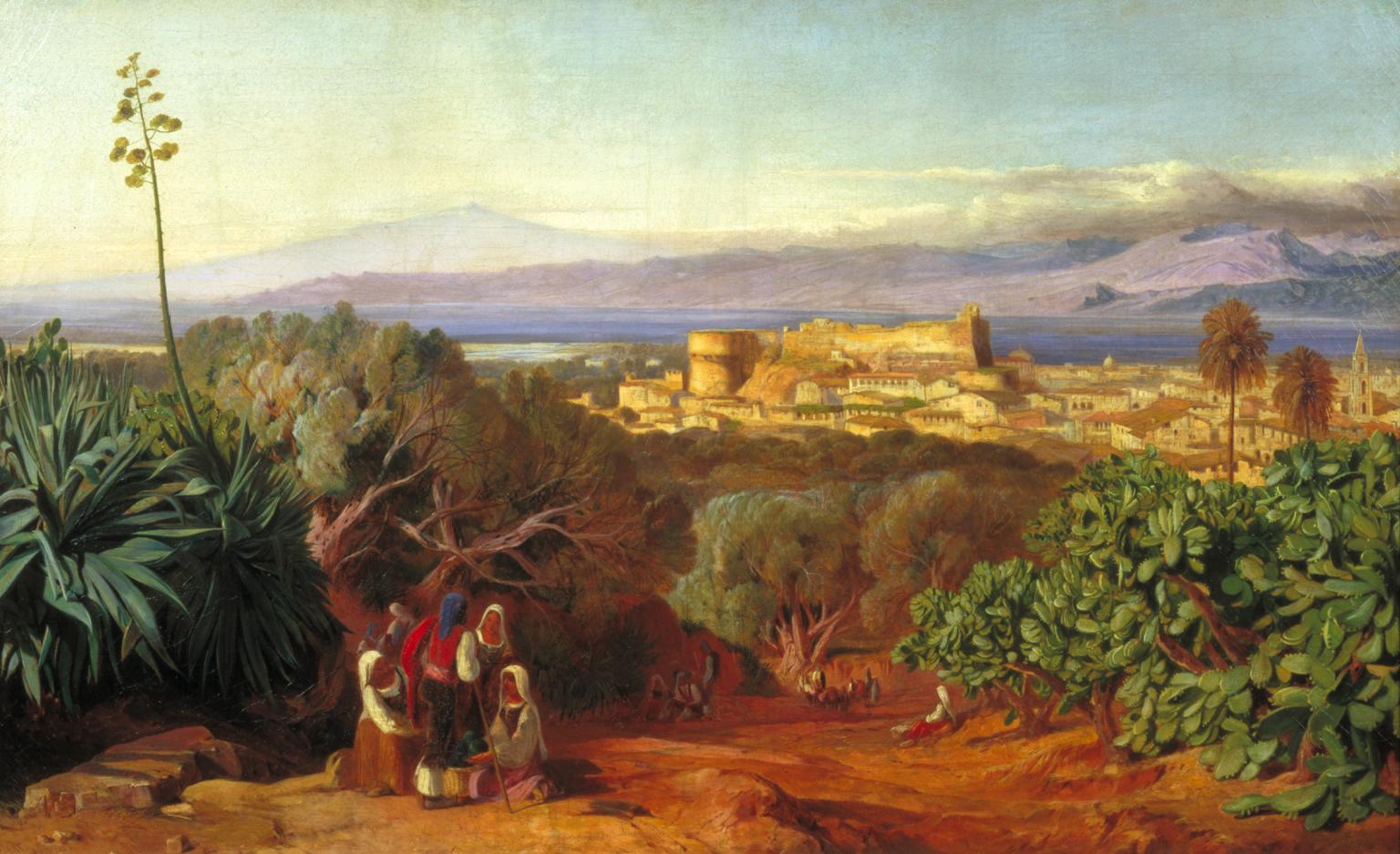
Edward Lear, View of Reggio and the Straits of Messina 1852
21/30
artworks in Beauty as Protest
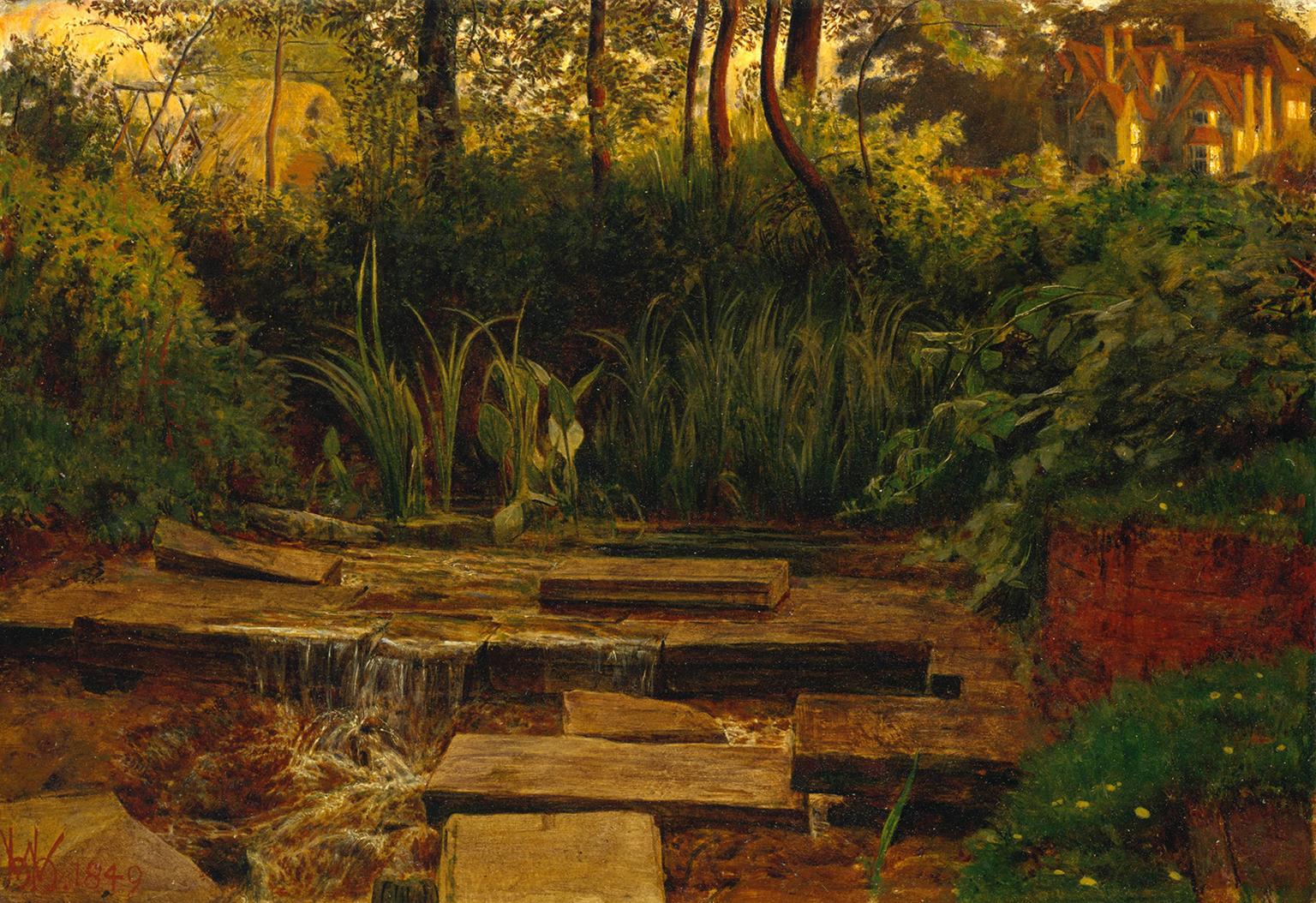
William Holman Hunt, The Haunted Manor 1849
Most of this landscape was painted in the open air in Wimbledon Park, in south-west London. The Pre-Raphaelite Brotherhood believed strongly in painting directly from nature.The picture has a low view point, filled with close and fastidious studies of plants, rocks and water. The murky tones of the waterfall and tangled vegetation contrast strongly with the narrow, brightly-lit strip of landscape at the top of the picture. It is likely that this and the deserted manor house in the top right were added later, to give the scene a mysterious atmosphere.
Gallery label, July 2007
22/30
artworks in Beauty as Protest
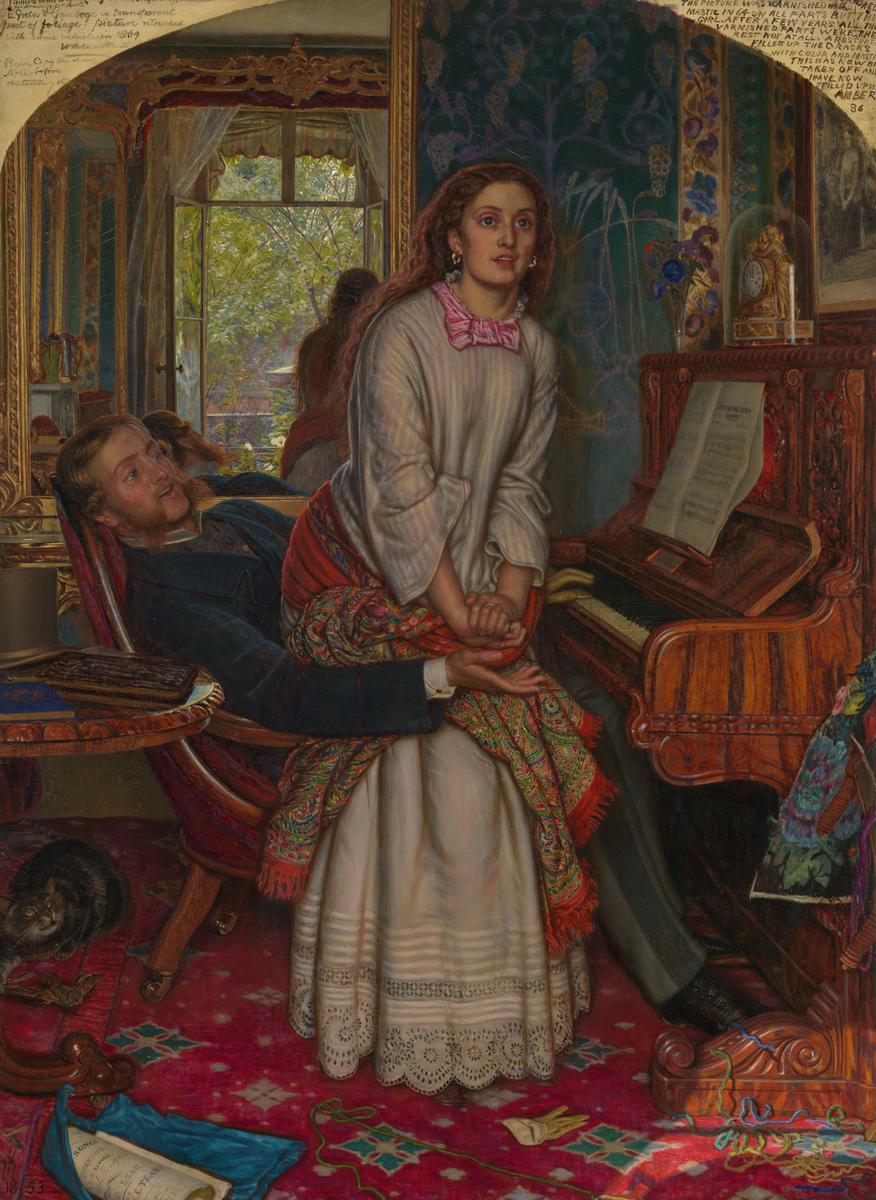
William Holman Hunt, The Awakening Conscience 1853
Hunt’s modern life painting represents a wealthy man visiting his mistress in an apartment which he has provided for her. The tune that he idly plays on the piano has reminded her of her earlier life and she rises from his lap towards the bright outside world (made visible to the viewer in the mirror). The claustrophobic space is filled with intricate clues, such as the bird trying to escape from a cat and the female figure enclosed in a glass dome, which echoes the shape of the painting.
Gallery label, November 2016
23/30
artworks in Beauty as Protest
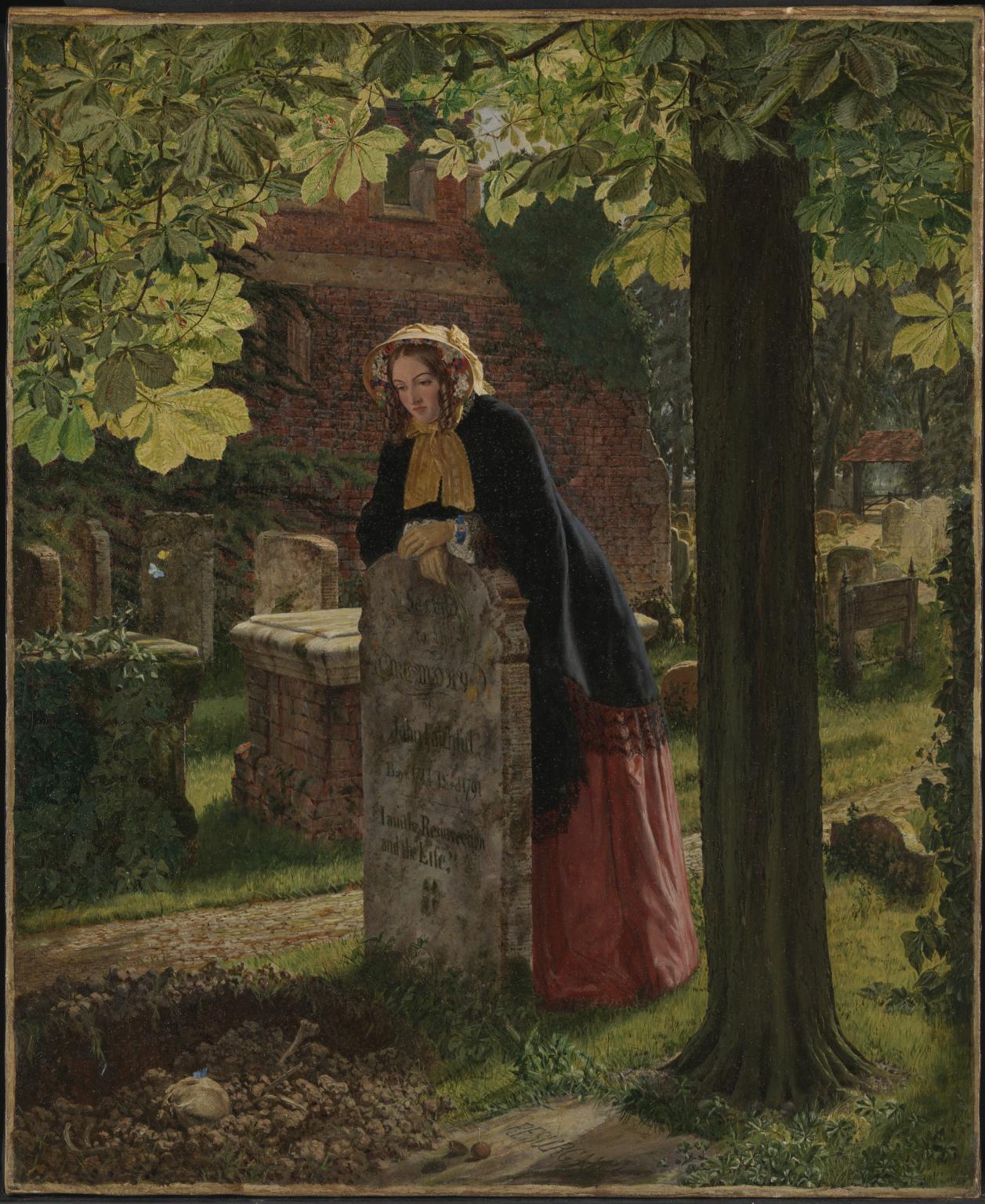
Henry Alexander Bowler, The Doubt: ‘Can these Dry Bones Live?’ exhibited 1855
This young woman, leaning on the gravestone of a man called John Faithful, is contemplating religious doubt. In particular, the Christian belief that the dead will be resurrected on the Day of Judgement. Long-standing religious beliefs were being disrupted at the time this was painted. New scientific publications explored theories of evolution, challenging literal readings of the Bible. Her question appears to be answered by the growing chestnut tree and the stone at its base, carved with the word Resurgam’, which translates as ‘I shall rise again’. The blue butterfly on the skull symbolizes the human spirit.
Gallery label, August 2018
24/30
artworks in Beauty as Protest
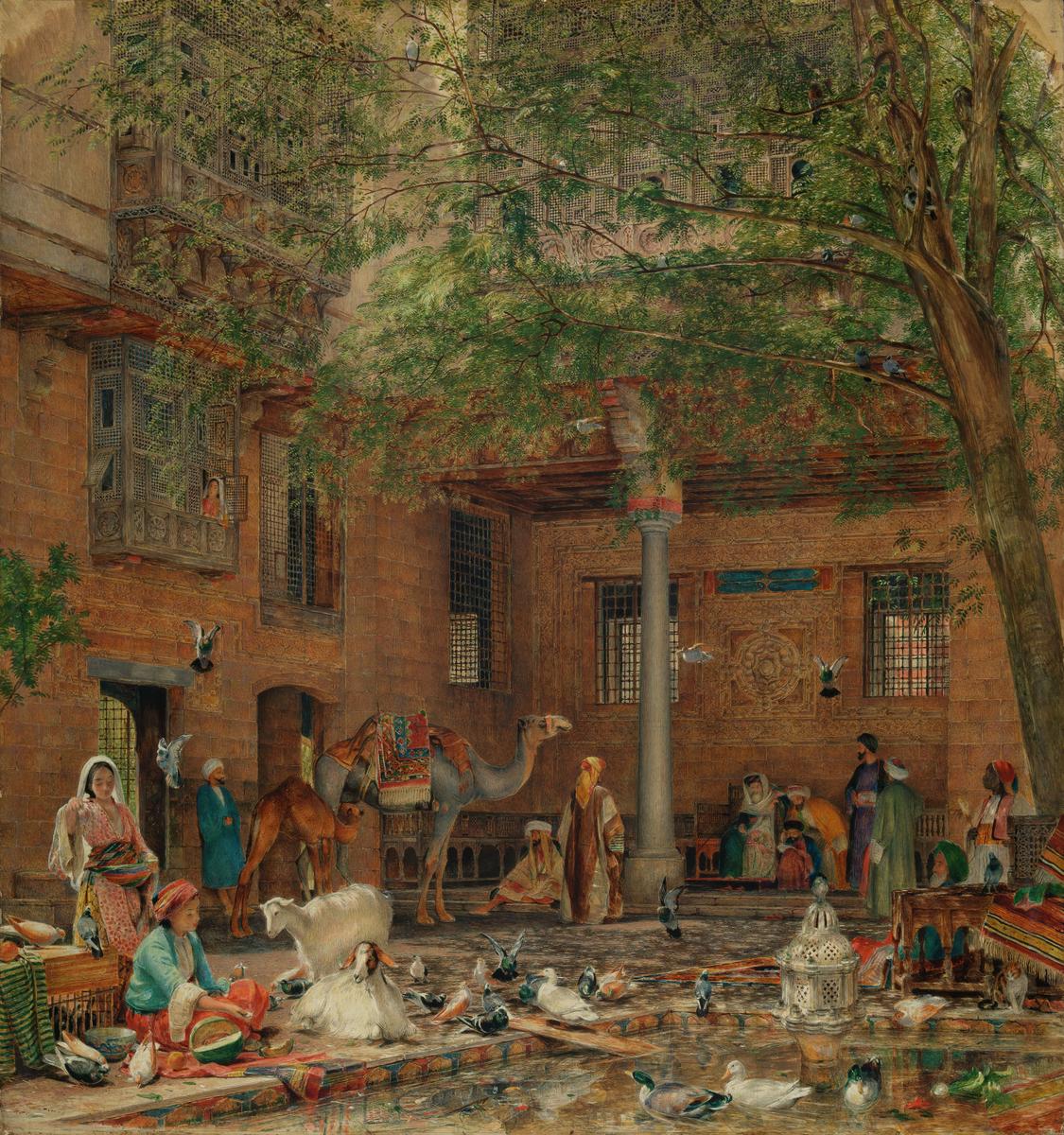
John Frederick Lewis, Study for ‘The Courtyard of the Coptic Patriarch’s House in Cairo’ c.1864
The Coptic Church is the ancient Orthodox Christian Church of Egypt. This study of the patriarch’s house was executed after Lewis’s return from Egypt in 1851, from the sketches he brought back. The picture highlights Lewis’s skill in depicting figures and setting with careful attention to light and shade, produced here by the top-lit courtyard. Lewis caused a sensation when he exhibited one of his Near Eastern scenes in London in 1850. John Ruskin admired his attention to detail, claiming that in truth-to-nature he ranked alongside the Pre-Raphaelite Brotherhood.
Gallery label, November 2016
25/30
artworks in Beauty as Protest
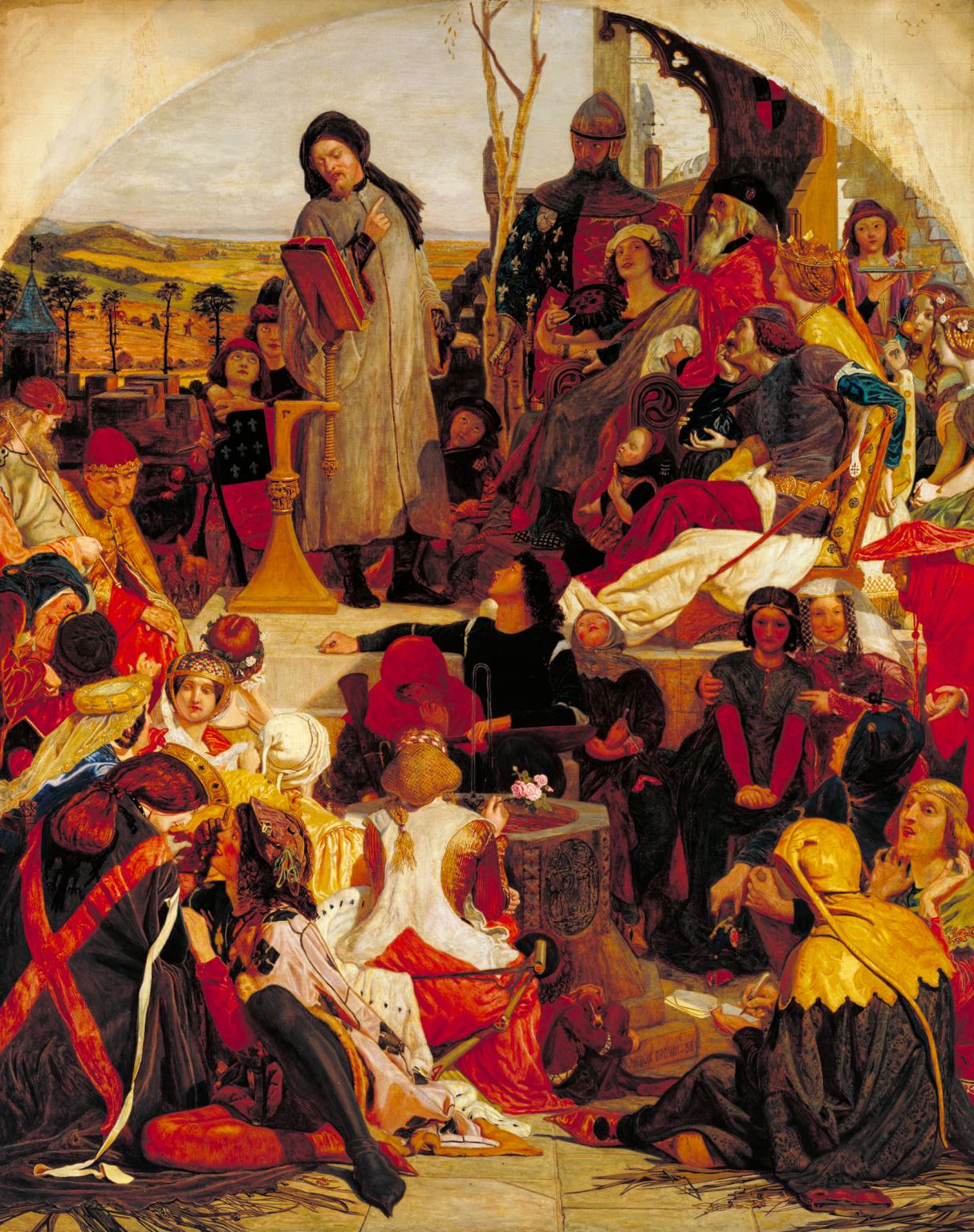
Ford Madox Brown, Chaucer at the Court of Edward III 1856–68
This picture is a replica of Ford Madox Brown’s largest and most ambitious painting, exhibited in 1851. It was significant for its portrayal of natural sunlight and was his first attempt ‘to carry out the notion ... of treating the light and shade absolutely, as it exists at any one moment, instead of approximately or in generalized style’. This pursuit of ‘truth to nature’ was consistent with Pre-Raphaelite ideals, as was his careful workmanship. The picture’s subject, Geoffrey Chaucer, reflects the growing popularity with artists of English literature instead of more conventional classical myths and biblical tales.
Gallery label, November 2016
26/30
artworks in Beauty as Protest
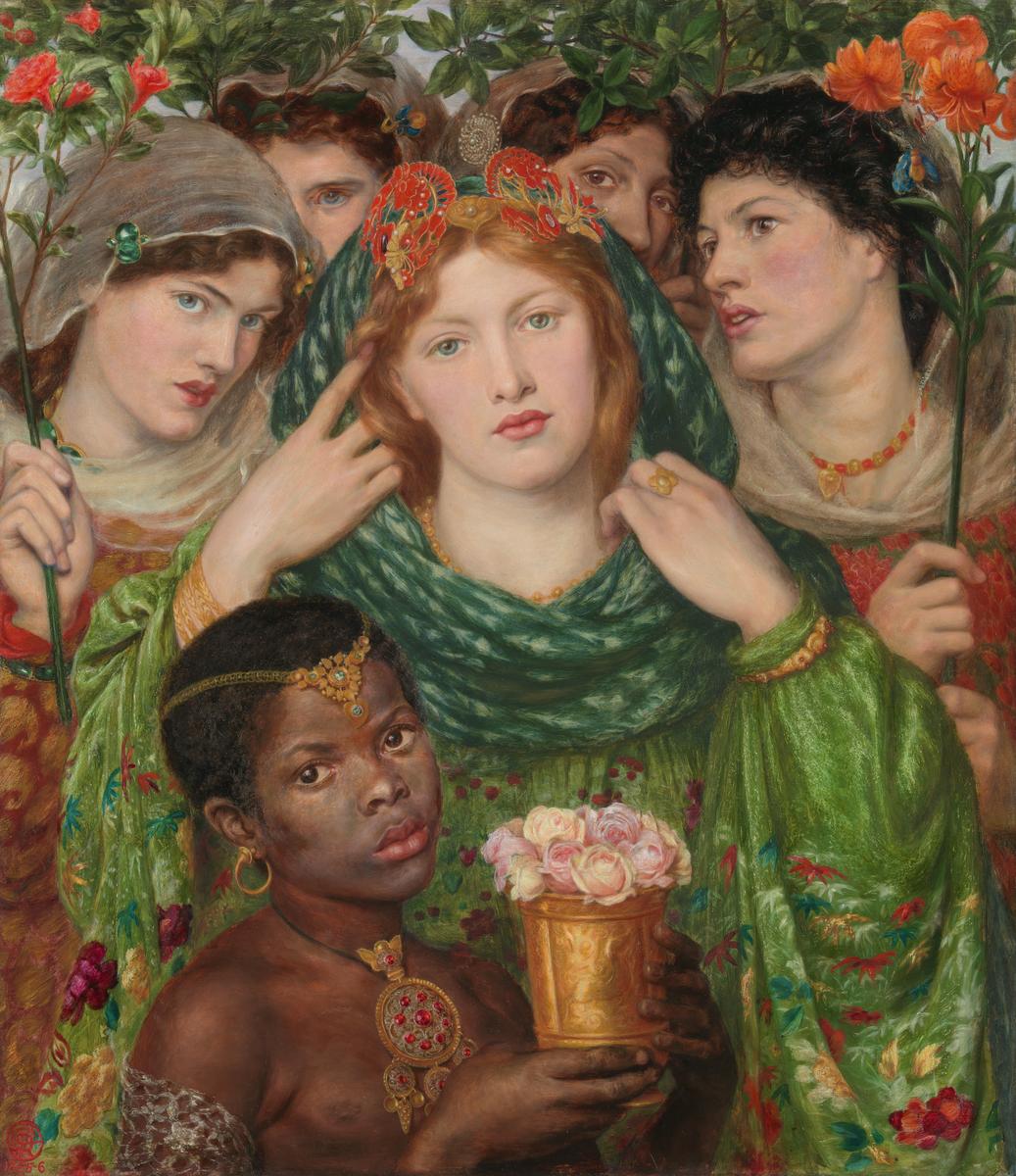
Dante Gabriel Rossetti, The Beloved (‘The Bride’) 1865–6
This work is inspired by the biblical Song of Solomon. It tells the story of a young woman preparing to marry. Rossetti shows her lifting a veil from her face, her eyes fixed directly on the viewer. The bride is surrounded by her attendants. In the foreground is a young Black child, holding roses. The women around the bride appear to have darker skin and hair than she does. Some modern commentators suggest that Rossetti is celebrating beauty and diversity. Others see it as racist, and argue that it imposes white standards of beauty, positioning the bride as superior due to the colour of her skin.
Gallery label, June 2019
27/30
artworks in Beauty as Protest
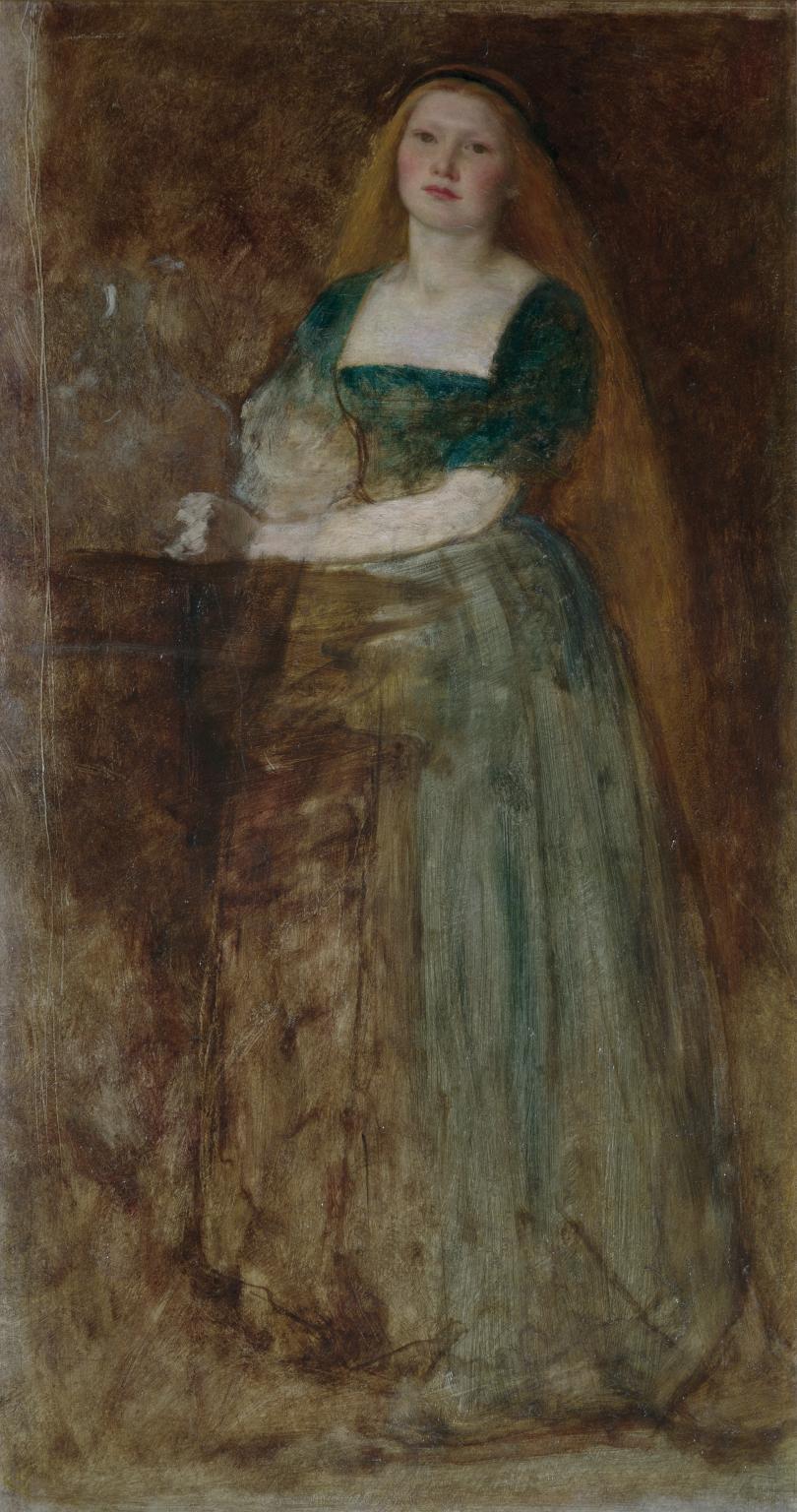
Joanna Mary Wells, Gretchen 1861
This picture alludes to a central scene in Faust, the tragic play published by German writer Johann Wolfgang von Goethe in the early 19th century. In the play, Gretchen, confused, seduced and pregnant by Faust, seeks solace in church. The sitter for the work was probably Wells’s nursery maid. Women artists had limited access to models at the time. Joanna Wells (née Boyce) had established a reputation during the 1850s as a painter of portraits, genre and landscape. She also wrote art reviews for the Saturday Review. Her career ended prematurely at the age of thirty. Wells herself was pregnant when she began this painting. She died shortly after the birth and the picture was left unfinished.
Gallery label, December 2020
28/30
artworks in Beauty as Protest
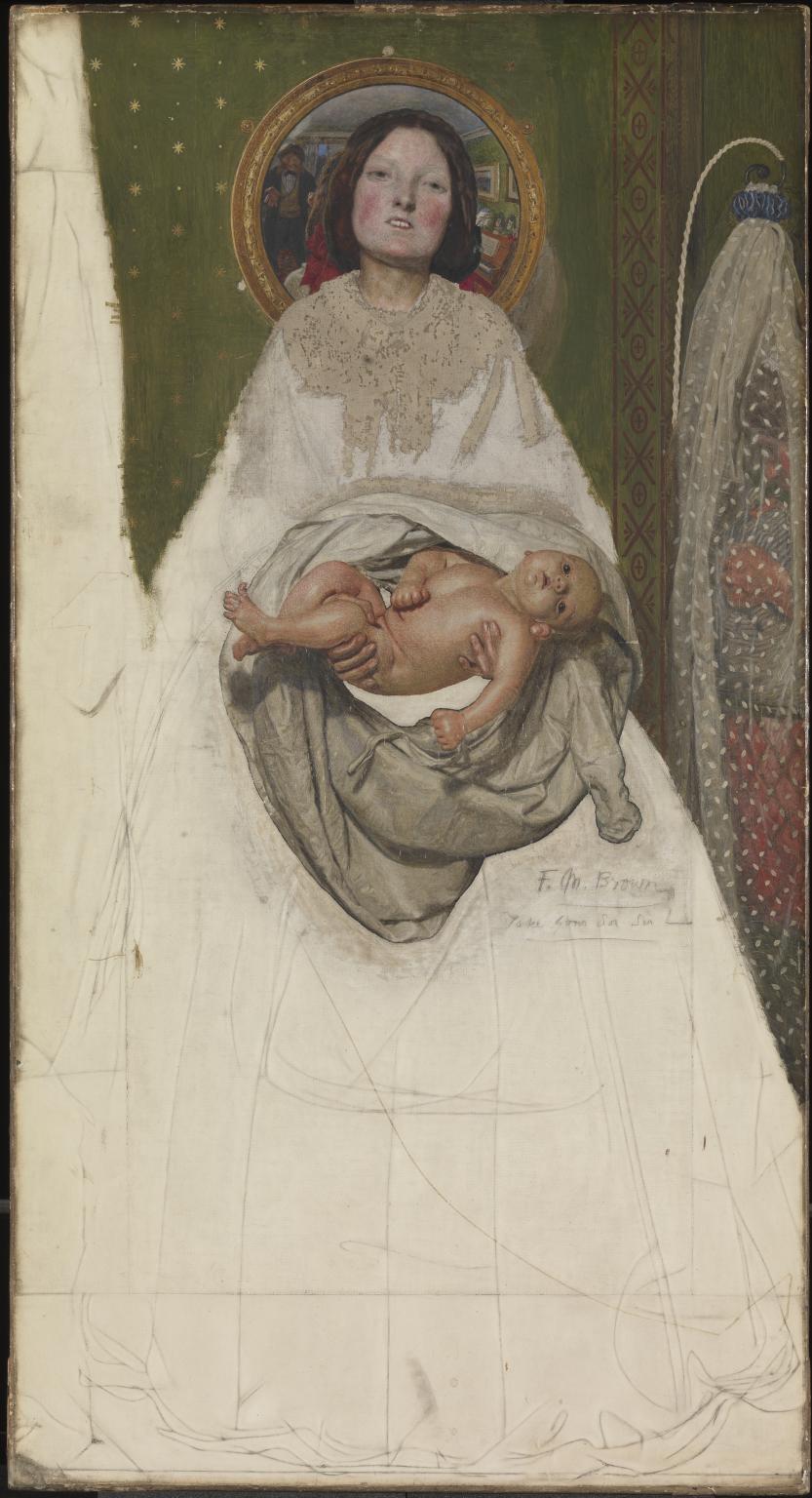
Ford Madox Brown, ‘Take your Son, Sir’ ?1851–92
This enigmatic picture shows the artist’s second wife, Emma, and their new-born son, Arthur Gabriel. The pose is reminiscent of a traditional Madonna and child but the mother’s strained expression suggests that this is not a conventional celebration of marriage and motherhood. The domestic details of the room are indicative of a contemporary-life subject in which the woman holds out the baby to her husband reflected in the mirror. Ford Madox Brown began the composition in 1851 and, although he worked on it over a number of years, abandoned it following the death of Arthur in 1857.
Gallery label, November 2016
29/30
artworks in Beauty as Protest
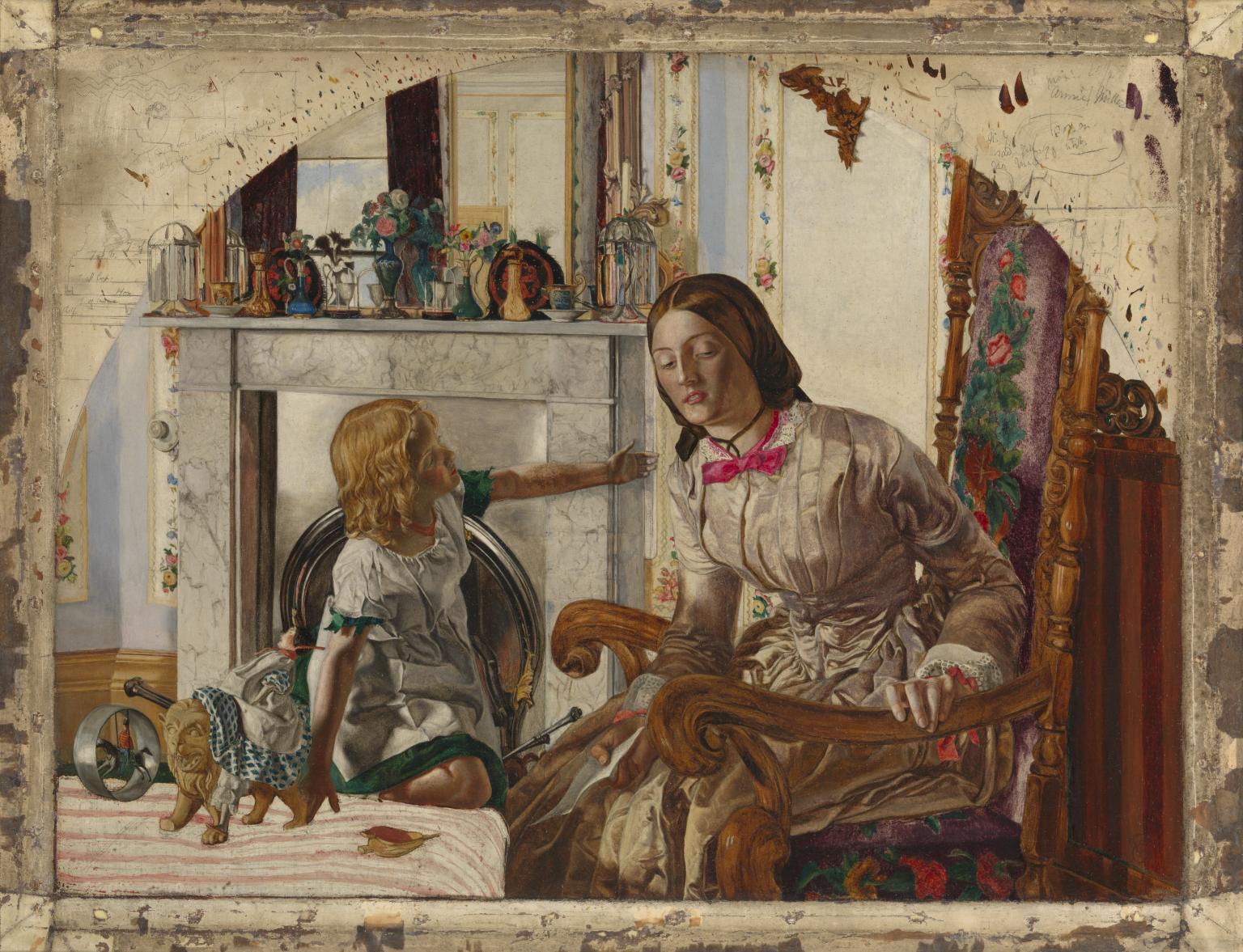
Frederic George Stephens, Mother and Child c.1854
Stephens painted this in the first year of the Crimean War (1853-6) and the major world event plays out in the setting of a Victorian nursery. The child pauses playing to reach towards his mother as she reacts to a letter which brings bad news from the conflict. Stephens encloses the figures in a curved frame like a traditional Madonna and Child and employs everyday objects, such as the military toys, as symbols. Stephen’s extremely detailed Pre-Raphaelite style was time-consuming and the picture was never finished.
Gallery label, August 2018
30/30
artworks in Beauty as Protest
Art in this room
Sorry, no image available
Sorry, no image available
Sorry, no image available



























You've viewed 6/30 artworks
You've viewed 30/30 artworks
